The Intel Xeon E3-1240 V3 model is the mid-range “affordable” Xeon E3. It is 100MHz faster each generation than the Xeon E3-1230 and 100MHz slower than the E3-1270. Price wise, it often also falls in the midpoint. With the Haswell Xeon generation, we expect to see a 5-15% IPC improvement although clock speeds are going to remain largely the same. The bottom line is that the 3.4GHz Intel Xeon E3-1240 V3 packs more performance in its 3.4GHz 4 core/ 8 thread design than its predecessors. Haswell, as we have seen previously, brings significant savings in terms of idle power consumption. All told, we are expecting lower idle power consumption with this generation of Intel Xeon E3-1240 V3 and an incremental bump in performance. Let’s see how the Intel Xeon E3-1240 V3 compares to other chips.
Haswell Xeon Test Configuration
To perform the testing we are using a review platform similar to what we used in in the Sandy Bridge, Ivy Bridge and even the older Xeon 3400 series generation. The goal is to provide a somewhat barebones processor platform typical of the datacenter use case where the server nodes are meant to fit easily within 1A per U power envelopes.
- CPU: Intel Xeon E3-1240 V3
- Motherboard: Supermicro X10SLL-F
- Memory: 16GB Kingston ECC 1600 CL11 DDR3 2x 8GB UDIMMs
- OS Drive: OCZ Vertex 4 256GB
- Enclosure: Norco RPC-4224
- Power Supply: Corsair AX750 750w 80Plus Gold PSU and PicoPSU 150XT with 150w power brick for power consumption testing.
- OS: Ubuntu 12.04 LTS
Nothing too exciting here. We will have more motherboard reviews in the near future. This should be a fairly typical configuration in the web hosting market except for the chassis. 4Us are simply easier to work with when we are swapping through test platforms daily.
Intel Xeon E3-1240 V3 Benchmarks
In previous Haswell benchmark articles, such as the Intel Xeon E3-1230 V3 and E3-1270 V3 reviews, we looked at both Linux and Windows (with the Xeon E3-1270 V3) benchmarks. Since we provided some guideposts in the Windows results, we are now focusing on the Linux benchmark suite. The data set is getting more significant as we test more CPUs each week.
Hardinfo Performance
hardinfo is a well known Linux benchmark that has been around for years. It tests a number of CPU performance aspects.
Two key themes can be seen here, and will be seen in subsequent benchmarks. The Intel Xeon E3-1240 V3 clearly starts to distance itself from the Intel Xeon E3-1220 V3 in terms of performance on multi-threaded tests. At the same time we can performance generally between the Intel Xeon E3-1230 V3 and E3-1270 V3. That makes sense given the same 4C/ 8T Haswell architecture.
UnixBench 5.1.3 Performance
UnixBench may be a defacto standard for Linux benchmarking these days. There are two main versions, one that tests single CPU performance on that tests multiple CPU performance. UnixBench segments these results. We run both sets of CPU tests. Here are the single threaded results:

In terms of single threaded performance, the Intel Xeon E3-1240 V3 does well. It again falls between its V3 siblings. When we look at multi-threaded performance, we can see the benefit of hyper-threading combined with high clock speeds.
Again we see strong performance here. The sub-$300 Xeon E3-1240 V3 clearly shows why it is a popular processor for many web hosts. Price/ performance wise it does well.
c-ray 1.1 Performance
c-ray is a very interesting ray tracing benchmark. It provides both consistent results and some clear separation. Ray tracing is generally a great multithreaded CPU benchmark. For this test we use both a simple 7500×3500 render and a more complex 1920×1200 render. Here are the results:
The Xeon E3-1270 V3 does post a 2 second delta from the E3-1240 V3 while the E3-1230 V3 is only a single second delta. In reality, there is not that large of a difference and it seems to be more of a function of rounding.
Crafty Chess Performance
Crafty is a well known chess benchmark. It is also one where we saw issues last time with the Phoronix Test Suite and running on ARM CPUs. Here are the Crafty Chess results from simply running “crafty bench”:
Here again we see a strong showing with the Intel Xeon E3-1240 V3 and it is placing on the chart where we would expect. In this single-threaded workload, the E3-1240 V3 proves to be a match for the much more expensive Xeon E5-2690.
Phoronix Test Suite Performance
We are using four tests from the Phoronix Test Suite: pts/stream, pts/compress-7zip, pts/openssl and pts/pybench.
- STREAM by John D. McCalpin, Ph.D. is a very well known memory benchmark benchmark. S
- 7-zip compression benchmarks were a mainstay in our Windows suite so we are including it again on the Linux side as a compression benchmark.
- The pts/openssl benchmark is very dependent on the CPU architecture being used
- Python is a widely used scripting language and pyBench is a nice single-threaded Python benchmark.
Here are the results of the Phoronix Test Suite benchmarks:
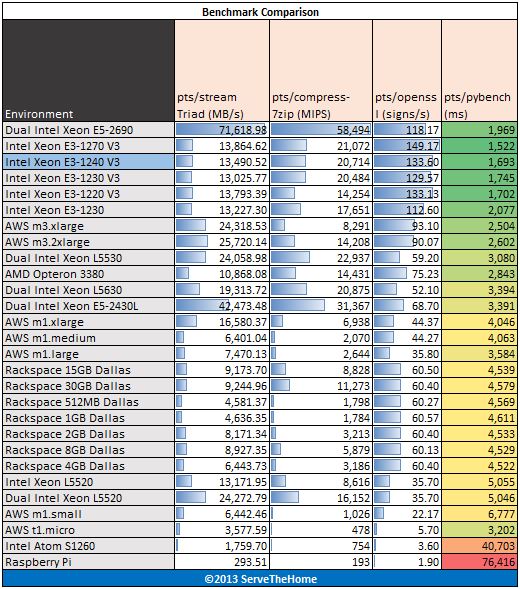
Overall, these results are in-line with expectations.
Intel Xeon E3-1240 V3 Power Consumption
Power consumption we saw is a bit of a trade-off with the Haswell generation. In our Intel Core i7-4770 review, we saw the Haswell generation provide noticeable idle power consumption and also a bit higher load power consumption.
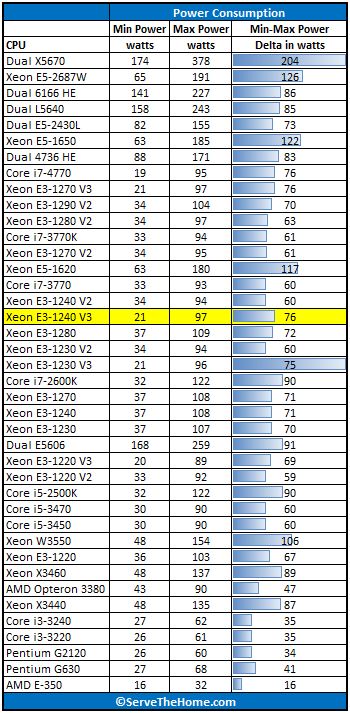
This chart highlights a few key aspects to this Haswell generation. First, min to max power consumption has a larger delta than in previous generations. We recorded a 76w difference with the Haswell part but only a 60w difference with the Ivy Bridge part. The impressive part is that the maximum values are similar but in terms of the idle values, the Haswell-based Intel Xeon E3-1240 V3 has a much lower idle power figure.
Conclusion
Overall, the Intel Xeon E3-1240 V3 has many strong points. As with the other reviews we have done on this generation of Xeon E3 processors, performance is certainly improved. The architecture is scaling fairly well in the 100MHz increments that Intel segments the line in. One major point is the fact that despite the fact that the E3-1270 V3 is numerically a 30 unit jump over the E3-1240 V3, it is the same 100MHz clock speed delta we see between the E3-1230 V3 and E3-1240 V3. Still, for a mix of cost and performance, the Intel Xeon E3-1240 V3 is a solid choice.

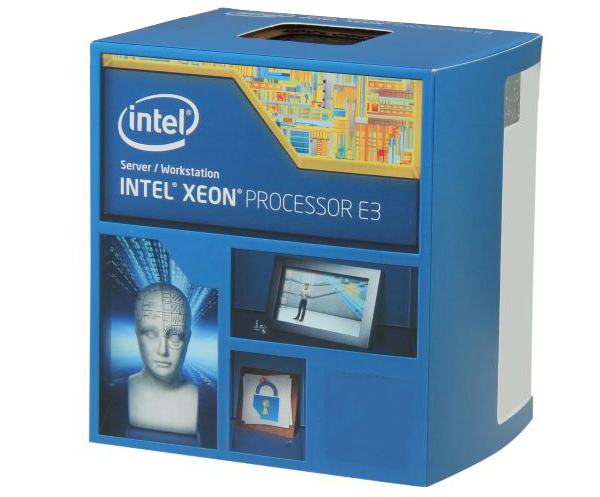
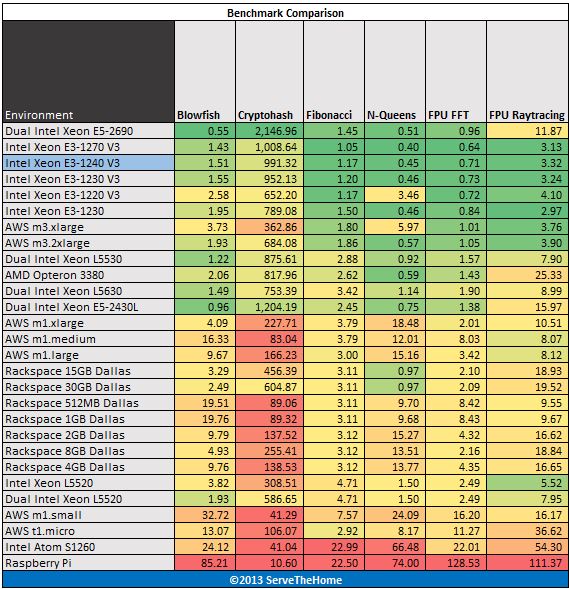

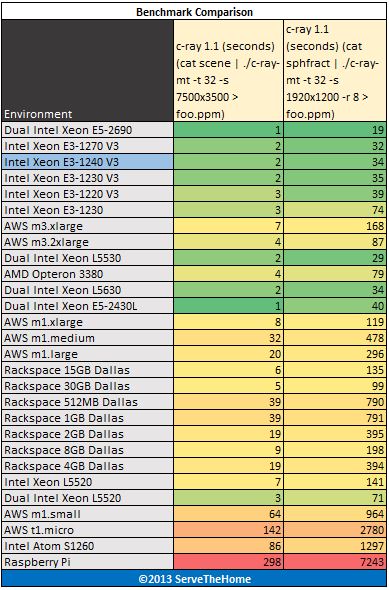




I think this is no use processor.
E3-1230 v3 is little less fast but less cost
E3-1270 v3 is max reasonable cost and max fast at cost
E3-1240 v3 is middle of cost and fast
Like review ^^
Question on the idle power tests as I am little confused on how you came with the idle numbers. Is there a standard like fixed number of memory without any add on cards? The add on cards skews the idle power significantly. For instance I was testing lga 2011 with e5-2620 and tested on a supermicro x9sra motherboard with 6 rdimm and 9 drives with same raid card. The idle power is 81 watts.
On a i7-2600 with same raid card and drive, fan, psu. The idle is at 72 watt. That is with 4 dimm vs 6 dimm. The mb I use for these test is asus matx evo. That is only 9 watt difference.
I also tested with only 1 hd and build in video card. I see 24 watts.
I can assume the idle with 1 sata drive is similar to the i7-2600 during idle. So it’s practically not much difference vs haswell on idle power.
So it maybe helpful to test with plain vanilla so many readers would be interested on the lga 2011 as the memory expansion 32gn vs 196gb is much more attractive and future proof. Also imagine if one is testing many instances of vms that requires lot more than 32gb, it makes more sense to go for lga 2011.
With that said, what would the idle numbers be for e5-1620 at idle?
Thanks very much
The e5-1620 (v1) is already in the chart, 63W min power…
Interesting would be the e5-1620 (v2) which is based on 22mm as well…
Is the idle power consumption for the whole system or just for the CPU? If it’s for the whole system then I’m not sure I see value in Avoton (especially since it can’t do vt-d).
Also you mention a PicoPSU and a Corsair power supply in the setup. Did you get different (lower) idle power consumption with the Pico?
Thanks
Eric